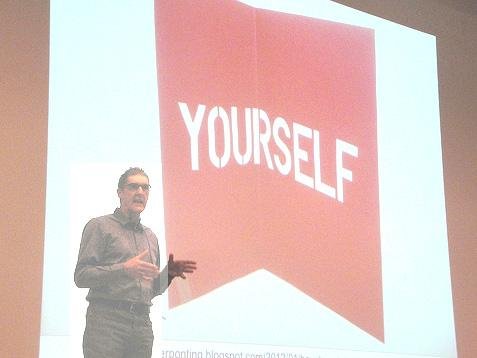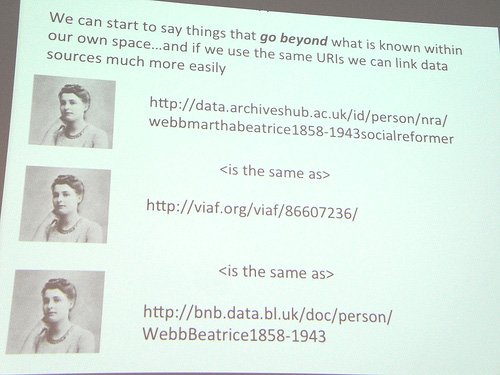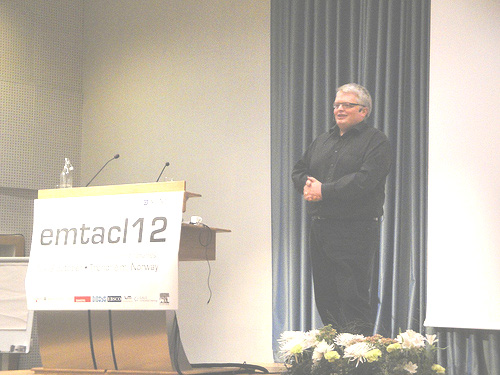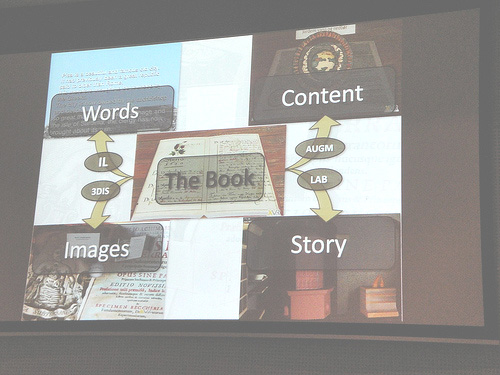EMTACL12 (Emerging Technologies in Academic Libraries)
Sarah Rayner and Olivia Walsby report on a three-day conference on Emerging Technologies in Academic Libraries, hosted by NTNU (Norwegian University of Science and Technology) in Trondheim, Norway over 1 - 3 October 2012.
The three-day conference consisted of eight keynote presentations by invited speakers and a number of parallel sessions. The main themes set out for this year’s conference were supporting research, organisational change within the library, linked open data and other semantic web applications in the library, new literacies, and new services/old services in new clothes, along with other relevant perspectives on emerging technologies.
We attended the conference to gain an overview of organisational changes happening across the sector in relation to technological developments and to gather opinion on the relevance of the academic library within a digital society. We also wanted to explore how the future exploitation of new technologies within libraries might have a positive impact on the quality of teaching and learning together with the student experience.
This article will summarise a selection of keynote and parallel sessions from across the three days that addressed these issues.
1 October 2012: Keynotes
Paint-Yourself-in-the-Corner Infrastructure
Herbert Van de Sompel, Los Alamos National Laboratory, USA
The opening keynote presented by Herbert Van de Sompel from Los Alamos National Laboratory in the USA raised the issues brought about by changes to scholarly communication. Herbert spoke about an increase in dynamic scholarly records that are continually in flux, interdependent, and Web-based, and with which our current infrastructures are unable to cope. With the publication of interdependent and executable papers, research is now a native Web activity; supporting the re-execution of algorithms and the ability to add data at any time (i.e. PLoS Topic Pages [1] PeerJ [2]). Herbert pointed out that, as a consequence, we now need to be able to view the state of a scholarly record at certain moments in time; to track back in time to see where findings have come from, and to trace the workflow, and therein lies a challenge for academic libraries.
Herbert explained that at present the archive infrastructure is only able to deal with static, non-fluxing research output, that, when using URIs, you will always come to the current version, not prior versions, and that Web archives are not integrated into the Web. As Herbert went on to point out, the key problem is that the Web was created without motion of time; existing in the ‘perpetual now’.
Herbert believes that the challenges we face in this new environment are two-fold: archival approaches need to be changed to use a different infrastructure; and we need to reassess how we reference scholarly assets. We have CMS records, Web archives, and caches, but it would be better to trace the history or timeline of a URI. Therefore, Herbert offered some potential tools and solutions; Memento [3] (started in 2009) allows you to track back to a past version of an item in the Internet archive, bridging current URIs to old URIs from the Internet archive, using a time gate. SiteStory [4] is a tool which allows your Web server to take an active part in its own archiving; every request from a user is pushed back to an archive and stored. Therefore, every time material is accessed, it is archived, thereby providing a true history of an object in the archive.

Herbert Van de Sompel (Photo courtesy of Lukas Koster, University of Amsterdam.)
In conclusion, Herbert suggested that archiving needs to be an ongoing activity, tracing every interaction, including archiving links at the time of publication to ensure that the context and history of an evolving piece of research will never be lost.
Think Different
Karen Coyle, Berkeley, CA, USA

Karen Coyle (Photo courtesy of Lukas Koster, University of Amsterdam.)
Karen opened by raising a challenge to the way in which libraries are still holding on to outdated practices, such as the librarian’s obsession with alphabetical order, describing it as essentially only ‘an accident of language’ and questioning its continuing relevance given the now pervasive ability to cross-search. Karen continued on this theme citing bibliographic hierarchies such as Dewey as ‘knowledge prevention systems’ which only serve to lock our users into a set view of what's out there.
Karen’s introduction led nicely on to the main themes of her presentation: the current role of the library, the need to move away from the view that getting the book into the user’s hand is the end game, and the need to change our attitudes to bibliographic control and linear order. In effect, ‘the library should no longer be about volume and ownership!’. Karen talked about how we should instead focus on how resources are used and what resources should be used together, to inform how we approach provision in the future. Karen believes that the library must become connected to information on the Web, providing more context for our users and thus allowing greater information discovery. Karen argued that the library’s role is no longer simply to gather items into an inventory but to seek to organise information that until now has been inconveniently packaged. She suggested that we need to change our view, to focus on the information and its context, not the objects or books themselves. Karen noted in particular that currently we present nothing within the context of time, reiterating the theme of time travel covered in Herbert’s presentation. So, how can we do this? Karen proposed that we should be able to interrogate catalogues to provide items with context. She gave examples such as WorldCat [5], where you can view timelines on people, what they have published and what has been published about them, giving a relative image of their importance.
Karen argued that although linked data could prove to be an answer, or could certainly help, we must nonetheless seek to find a range of solutions and technologies. She warned that the pitfall of having an answer is that it stops you asking questions! Karen talked about how libraries must now recognise that bibliographic data are available everywhere, and that what libraries have that is essential and unique are the details on holdings. She proposed that on searching the Web, part of the rich snippet should include information about what the library holds and whether it's available. The Web should be used to direct readers to their library holdings, as well as making use of data such as location information, already being sourced by search engines. Karen’s concluding remarks were that libraries need to look to this new approach (using tools such as Schema.org [6]) or they will lose visitors, and that if we want to remain visible and relevant, we need to be where our users are - on the Web.
1 October 2012: Parallel Sessions
The Winner Takes it All?: APIs and Linked Data Battle It Out
Adrian Stevenson and Jane Stevenson, MIMAS, The University of Manchester, UK

The Winner Takes it All? (Photo courtesy of Lukas Koster, University of Amsterdam.)
Jane and Adrian from the MIMAS National Data Centre at The University of Manchester debated the use of linked data versus APIs in aggregating data for reuse in projects such as LinkingLives [7], which again looks to set information within the context of time, connecting people and events, as well as World War 1 Discovery [8]. They compared and contrasted the outcomes and experiences from these two projects, highlighting the pros and cons of each approach, and in the end came to the conclusion that each had its strengths (and weaknesses) and that therefore both had their place on such projects! This supported the argument Karen made; that we needed to find a range of solutions and to challenge them continually.
2 October 2012: Keynotes
Innovation Management in and for Libraries
Rudolf Mumenthaler, University of Applied Sciences HTW Chur, Switzerland
In the first keynote of the day, Rudolph Mumenthaler gave a very engaging talk on the importance of innovation management in libraries. His starting point was to suggest that libraries are currently in the ‘eye of the hurricane’ in relation to technological developments over which they (largely) have no control and to which they can only react. In other words, development happens in sectors outside of the library and then our users bring them into the library whether we like it or not. These technologies have a massive influence on the ways that our users want to engage with the library services, resources and physical spaces.
Rudolph inferred that if (as he believes) we can’t influence the development of new technologies, what we can do is foster a culture of innovation within our institutions, in order to exploit these technologies to our best advantage. Profit companies have always done this, but to libraries it is unknown territory.
In order to develop a spirit of innovation, Rudolph claimed that it is essential to establish some form of innovation management structure within the library. This involved creating an organisational framework to support the innovation process, defining the workflow from idea to product and introducing some form of ideas management.
He believed that it was imperative to involve people too. Staff from across departments could get involved through an innovation circle or team where they could discuss ideas that would then be fed back to leadership teams. In order to broaden the scope for ideas, we also needed to involve our customers via initiatives such as innovation challenges using Web 2.0 technologies and feedback tools.
Most importantly of all, we had to establish a culture where it was OK to fail. Innovation management could not replace the spirit of ideas but it could provide the framework for it to grow and live. Rudolph summed up the whole ethos behind creating innovation in libraries by saying that good innovation management came down to giving your staff time to try things out – that was it.
Forecast for the Academic Library of 2025: Cloudy with a Chance of User Participation and Content Lock-in
Eirik Newth, Astrophysicist, writer of popular science for children, and media personality, Norway

Erik Newth (Photo courtesy of Lukas Koster, University of Amsterdam.)
Eirik Newth delivered an absorbing talk on futurism. He made an interesting prediction related to the current trend of body modification and future internalisation of personal computing – suggesting that as people are already comfortable with tattooing and piercing themselves it’s not such a radical step to imagine future relationships with devices and services becoming very personal– being literally attached to our bodies. Or as he put it, ‘computing going personal in a physical sense’!
He also talked about cloud computing and the impact it will have on how we store and access data. We will be able to centralise all our data and access it from anywhere with any device. However, any models for open content using this technology are faced with the problem that companies are trying to lock people down to their content. Eirik suggested that the future may see a move back to Windows as he believes Window 8 is looking to bridge the gap between different devices.
2 October 2012: Parallel Sessions
Mubil: A Digital Laboratory
Alexandra Angeletaki, NTNU University Library, Norway & Marcello Carrozzino and Chiara Evangelista, PERCRO - Scuola Superiore, Italy

Mubil: A Digital Laboratory (Photo courtesy of Lukas Koster, University of Amsterdam.)
The MUBIL Project [9] is an international interdisciplinary collaboration designed to disseminate the content of old books from the Gunnerus Library, NTNU. Alexandra and Marcello introduced us to the fascinating work they have been doing using 3D technology to enhance social engagement and knowledge dissemination for new groups of library users. Alexandra talked in particular about how they planned to use the project to gather data on how young people interact with such 3D software and virtual objects in a library setting, through the use of storytelling and gaming.
Making Connections: Enhancing Teaching and Learning at The University of Manchester
Olivia Walsby, The University of Manchester Library, UK
Olivia delivered a very informative break-out talk speculating on the future of the academic librarian. The main theme of the talk highlighted the importance of the emergent role of the ‘academic engagement’ librarian in linking together new technologies, libraries, academics and developers to provide an outstanding learning experience for our students.
She charted her own personal journey through involvement in the use of mobile technologies for learning at The University of Manchester. She outlined several ventures including e-reader projects established to improve access to undergraduate texts in humanities through Project Scarlet [10] which used Augmented Reality to unlock special collections material, to the many iPad projects that are currently running in several schools across campus.
One of the main themes running through the conference was change and the continued relevance of academic libraries. Olivia picked up on this by describing how The University of Manchester Library is attempting to do just that, by setting her talk within the context of the recent restructure of their Research and Learning Services. The new structure sees the Library making a radical departure from the traditional subject team approach to a functional model which will enable it to be more responsive to the needs of its user community, and better placed to keep pace with the speed with which technology is developing.
The Triadic Model: A Holistic View of How Digital and Information Literacy Must Support Each Other
Andrew Whitworth, The University of Manchester, UK
Andrew Whitworth’s session concentrated on the need to develop information literacy skills to allow sustainable learning within a society where information is now largely digital in its ‘provision, organisation and dissemination’. Andrew suggested that digital literacy, information literacy and media literacy were essentially the same or at least overlapped; each was concerned with choices, and the need to review them continually. He talked about learners making personal choices in their learning, such as preferences for particular types of technology and resources - including whether or not to use the Library. He suggested that personal choices like this were often made, or certainly influenced by, external factors such as proximity, peer pressure and routine, raising the question as to who were making these choices and whether those choices received adequate and careful consideration. Andrew went on to say that he believed there was a need for learners to be able to read the environment around them and make selections, without falling into routine, including the ability to write back into the community. Andrew quoted Wenger, White and Smith’s description of the need for ‘stewards’ of the ‘digital habitat’ [11], emphasising the importance of processing information rather than its mere consumption. He suggested that all too often we, as ‘stewards’, fail to complete the learning cycle; not supporting users in the key skill of writing up their learning effectively. Andrew explained that the responsibility for the delivery and support of such skills should be shared across the University. However, he cited issues of silos within academic institutions forming a barrier to their effective support, often relying on external bodies and funding to provide the glue which would bring this type of collaborative work together.
The Possibilities of Social Media to Promote International Collaboration
Mark Puterbaugh, Eastern University, Pennsylvania & Hua San, Shandong University of Arts, People's Republic of China (PRC)
Joining us from China via Skype, Mark and Hua gave a unique presentation which demonstrated the way in which social media could be used to encourage international collaboration. Mark, from Pennsylvania, USA, talked about his own experiences of using Skype, amongst other methods of communication, to collaborate with Hua San, in Shandong Province in the PRC, to create a subject guide of Chinese history and culture. Paul detailed the problems involved in forming international partnerships, such as physical distance, technological variations, culture and language, and discussed the role that social media can play in overcoming these obstacles. He explained, in particular, how social media supported both synchronous and asynchronous communication. Paul concluded that academic libraries could now ‘tap expertise in other cultures to improve and extend their services without the huge financial cost once attributed to international collaboration’.
3 October 2012: Keynotes
Connecting People and Information: How Open Access Supports Research in High Energy Physics
Jens Vigen, CERN Scientific Information Service, Switzerland

Jens Vigen (Photo courtesy of Lukas Koster, University of Amsterdam.)
Jens Vigen delivered a very interesting case for open access in his talk entitled "Connecting People and Information: How Open Access Supports Research in High Energy Physics. Since 50 years!". He referred to the fact that the CERN convention of 1953 already effectively contained an Open Access Manifesto "...the results of its experimental and theoretical work shall be published or otherwise made generally available..." He also talked about SCOAP3 [12] (Sponsoring Consortium for Open Access Publishing in Particle Physics), the purpose of which is to introduce a funding model where libraries, library consortia, research institutions and funding agencies use their subscription budget to pay open access fees. In other words, we should pay publishers for peer review and not for content.
What Next for Libraries? Making Sense of the Future
Brian Kelly, UKOLN, University of Bath, UK
In the closing keynote presentation of the conference, Brian Kelly delivered a very entertaining talk using the past to examine the future! He began by drawing our attention to the major difference between the ’classroom’ of 1969 and 2012, which is that now most students have several mobile devices. He further demonstrated this point by asking us to hold up our own mobile devices - most delegates had at least two!
Brian made humorous reference to certain predictions of the future from our youth which failed to live up to our expectations, such as the monorail, lunar bases and the jetpack. What child of the 1950s or 1960s can honestly say they didn’t imagine that in the future they would be flying to work on some kind of jet-propelled device and holidaying on the moon? He used this analogy to emphasise the fact that our expectations of the impact of new technologies and inventions are often limited to them merely automating existing practices rather than transforming them.
Continuing the theme of innovation, Brain stated that in tough economic times we still need innovation but we need to focus it. He referred to the work done by the JISC Observatory [13] on systemising the processes for responding to predictions of future trends. The work involved ‘evidence-gathering processes’ which can help to identify early trends as well as moves away from well-established technologies and ‘sense-making’, where the evidence gathered is interpreted. However, Brian also pointed out that even if we do all this there will always be an element of ‘unknown unknowns’ that we will never be able to plan for.

Brian Kelly compares expectations with emerging reality
3 October 2012: Parallel Sessions
Designing Tools for the 21st Century Workflow of Research and How It Changes What Libraries Must Do
Sharon Favaro and Christopher Hoadley, Seton Hall University, NJ, USA
Sharon discussed the issues faced by researchers in using the many tools now available to them, and highlighted the ‘profound disconnects between library-oriented resources and tools, and the other tools scholars use to do their work’. She suggested that libraries need to seek to provide tools which will support the whole researcher life cycle, not just information retrieval. With this comes a need to integrate the software that researchers are using, from Google Docs to bibliographic referencing software and archives. She explained how she saw it as the Library’s role to provide a safe working environment for researchers, and she and her colleagues were seeking to create a platform that could provide a smooth transition between searching and the following processes of the researcher life cycle. In line with other speakers at the conference, Sharon talked about the need for the library to be in our users’ spaces rather than expecting them to come to the library. She suggested that by supporting the researcher life cycle from beginning to end in an online environment we could begin to do this.
Publication Profiles: Presenting Research in a New Way
Urban Andersson and Stina Johansson, Chalmers University of Technology, Sweden
This breakout session provided an example of how the library could use the extensive and well-structured data contained within the institutional repository to promote the research output of its university. Urban began by explaining the work they have been doing at Chalmers University of Technology, collating data to create an open access platform of publication profiles. He went on to explain that from the profiles they could then begin to build further services to promote open access publishing and collaboration, such as adding in citation information, providing publication profile mapping, and also integrating social network services, such as LinkedIn.
Stina Johansson then presented the work they had undertaken so far using the data to look at co-authorship, and mapping research partners geographically. Stina explained how they had cleaned the data and then used GPS to plot the location of researchers using Google Maps.
Conclusion
To summarise, the main themes that struck us from across the three days were:
Time travel: Within the context of a digital, Web-based society, the need now for libraries both to track ever-evolving research processes across time, and to set information within the context of time for our users. This will change our approach to archiving and using a variety of different software and solutions.
Working in our users’ space: Libraries now need to ensure, in order to remain visible and relevant, that they are reaching into their users’ spaces, rather than expecting them to come to us. Libraries need to ensure that they are on the Web and that they are connecting and integrating library resources and services to all those used in the learner/researcher life cycle. They need to ensure that this process is supported from beginning to end, from information discovery to academic output.
Innovative use of technology: The time for developing innovative technologies within libraries has passed, our future approach should be to look outside the sector for new technologies and decide which are appropriate for our use and how we might contextualise their use in an innovative way, ie gaming, social media, etc. We need to ensure that we manage this process effectively, encouraging new ideas from both staff and our user community. We should also develop a culture of experimentation (where failing is OK), and share experiences of both successes and failures with our peers, working collaboratively across the sector.
References
- PLoS Topic Pages http://topicpages.ploscompbiol.org/wiki/Topic_Pages
- PeerJ https://peerj.com/
- Memento http://mementoweb.org/
- SiteStory http://mementoweb.github.com/SiteStory/
- WorldCat http://www.worldcat.org/
- Schema.org http://schema.org/
- LinkingLives http://archiveshub.ac.uk/linkinglives/
- World War 1 Discovery http://ww1.discovery.ac.uk/
- MUBIL http://folk.ntnu.no/angeleta/mubil/index.htm
- Project Scarlet http://teamscarlet.wordpress.com/
- Wenger. E, White. N and Smith. John D., Digital Habitats: stewarding technology for communities, Portland, OR: CPsquare, 2009.
- SCOAP3 http://scoap3.org/
- JISC Observatory http://blog.observatory.jisc.ac.uk/
Author Details
Email: sarah.rayner@manchester.ac.uk
Web site: http://www.manchester.ac.uk/library
Sarah Rayner has worked in libraries since 1998 and completed an MA in Library and Information Management at the Manchester Metropolitan University in 2003. She has recently taken on the newly created role of Teaching and Learning Manager at The University of Manchester Library. Sarah’s current professional interests include thinking strategically about the library’s contribution to teaching and learning at The University of Manchester, with a particular focus on innovation, new technologies and improving the student experience.
Email: Olivia.walsby@manchester.ac.uk
Web site: http://www.manchester.ac.uk/library
Olivia Walsby currently works as an Academic Engagement Librarian at The University of Manchester Library, having spent the past 12 years within the academic libraries sector. Her experience includes Research & Learning Support, E-Learning and Electronic Resources Delivery. Olivia’s professional interests include the developing liaison and marketing role of the academic librarian, and the use of new technologies to support teaching and learning, and to enhance the student experience.
